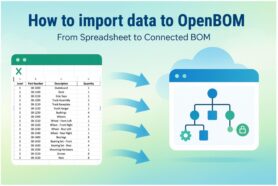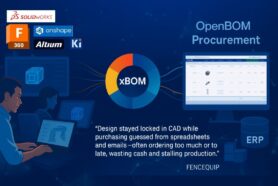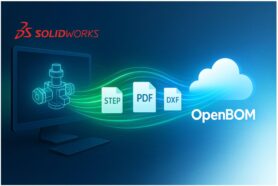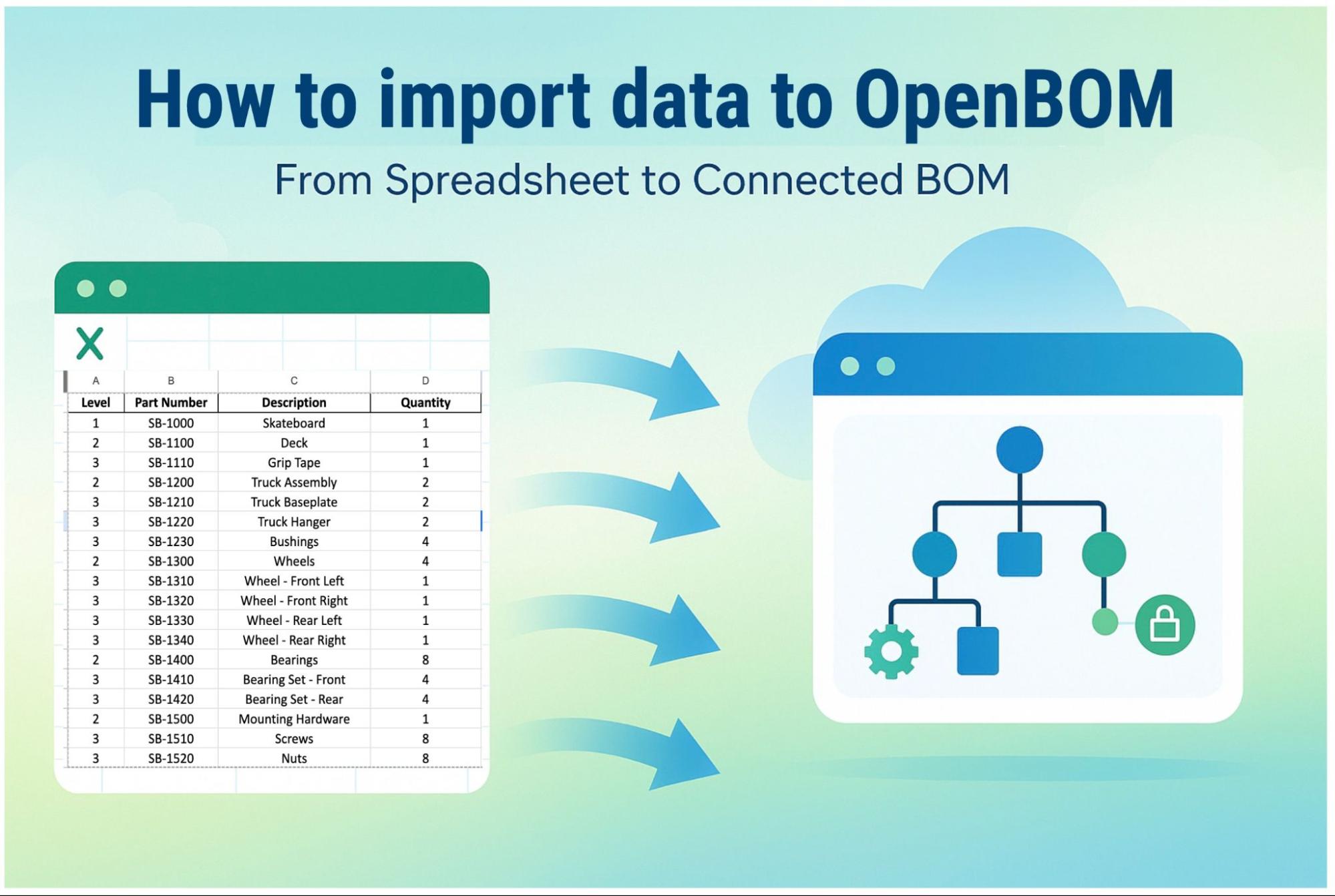
Spreadsheets have been the backbone of product data management for decades. Every engineering team has one — or a hundred. Whether it’s an Excel file or a Google Sheet, product information often starts its life there: part numbers, descriptions, quantities, vendors, and costs.
The challenge comes when this information needs to evolve into a structured, traceable, and connected data model.
OpenBOM simplifies this transformation. With just a few clicks, you can bring your spreadsheet data directly into OpenBOM’s cloud-native environment — automatically creating and organizing Items, Catalogs, and Bills of Materials (BOMs) without complex mapping or manual setup.
Even better, OpenBOM’s new unified import process (introduced in August 2025) streamlines everything into a single operation. Instead of importing items and BOMs separately, OpenBOM now performs both actions together — intelligently creating and updating Catalog Items while building the BOM structure in one step.
Understanding the OpenBOM Data Model
Before importing, it’s helpful to understand how OpenBOM organizes information. The platform uses a data model built around two core concepts: Catalogs (Items) and BOMs.
Catalogs and Items
A Catalog is a collection of Items — parts, assemblies, materials, or anything else that forms part of your product definition.
Each Item in a Catalog has attributes known as Catalog Properties, such as:
- Part Number
- Description
- Cost
- Vendor
- Material
- Revision, and more
Catalogs define what an item is — its identity and specifications — and serve as the single source of truth for item information across BOMs.
Attributes (OpenBOM properties) are fully customizable. You can add/delete/update any attribute, which makes OpenBOM capable to bring any information from any spreadsheet.
BOM and Instance Properties
A Bill of Materials (BOM) defines how items are used to build a specific product or assembly.
While Catalogs describe items, BOMs describe relationships between them.
Each line in a BOM is an instance of an Item and contains Instance Properties, such as:
- Quantity
- Reference Designator (RefDes, common in PCBs)
- Position, Location, or other contextual details
- Any additional calculated properties (eg. Total cost)
This separation between Catalog (item-level) and BOM (instance-level) data is what makes OpenBOM’s import model powerful and flexible.
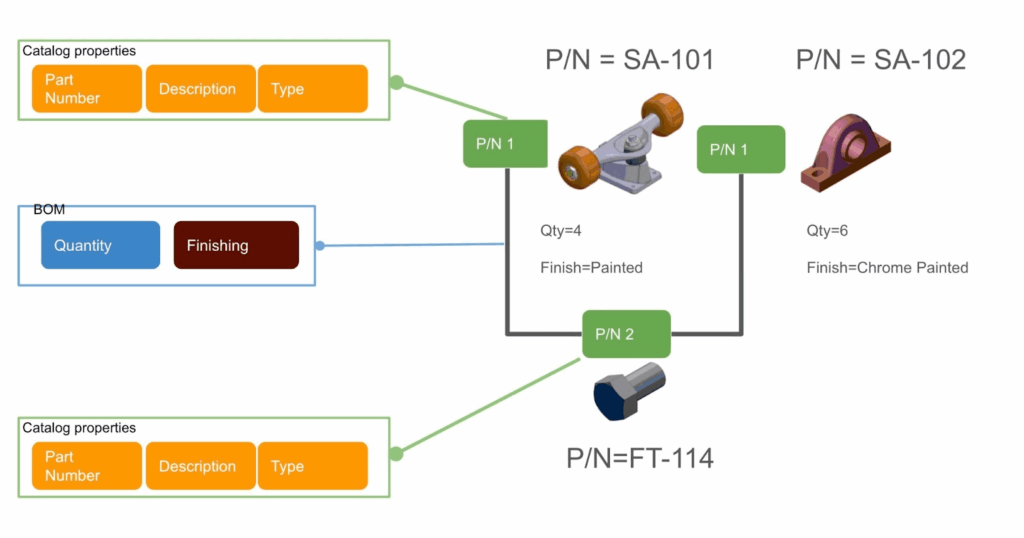
Check more information about OpenBOM data model in this article – Reference–Instance Product Structure
Why the Data Model Matters for Import
When importing from a spreadsheet, understanding how Catalogs and BOMs relate ensures the data lands in the right place.
- Catalog properties define item attributes.
- BOM properties define how those items are assembled.
By structuring your spreadsheet with these roles in mind, you ensure a smooth, predictable import process.
The OpenBOM Import Operation
OpenBOM provides flexible ways to bring in your existing data from Excel or Google Sheets.
Ways to Invoke Import
There are two main ways to start an import:
- From the Dashboard – “Create → Import”
- Used to create a new BOM or Catalog.
- Ideal for first-time imports or new assemblies.
- From inside a BOM or Catalog – using the Import Icon
- Used to update existing data.
- Adds or updates items, properties, and structure.
Import Types
OpenBOM supports three major import operations:
- Import/Update a BOM – includes both the BOM structure and Catalog Items in one step.
- Import/Update a Catalog Only – updates or creates item data without BOM structure.
- Import a Vendor List – for supplier and vendor data (documented separately).
What Happens During Import
Unified Import Operation (OpenBOM Post-August 2025 release)
OpenBOM’s latest update simplifies the import workflow dramatically.
Previously, users needed two steps — first importing a Catalog, then a BOM.
Now, BOM imports are single operations.
When you import a BOM spreadsheet, OpenBOM:
- Automatically creates or updates Catalog Items based on Part Numbers.
- Builds the BOM hierarchy and structure.
- Adds new properties (columns) discovered in your file.
- Creates an Imported Items Catalog if no default Catalog exists.
The process now mirrors how CAD integrations work — simple, fast, and unified.
Automatic Detection and Property Handling
OpenBOM intelligently analyzes your spreadsheet headers and classifies each column as a Catalog or BOM property.
- Part Number and Quantity are automatically recognized as BOM instance properties.
- All other columns are treated as Catalog properties by default.
If your spreadsheet contains special BOM properties such as RefDes, Location, or Serial Number, you can control where they go by adding those properties to the BOM before import. This ensures OpenBOM maps them correctly as BOM-level data.
Tip: In upcoming releases, BOM templates will make this process even easier by allowing you to predefine which properties belong to a BOM before importing.
How the Spreadsheet Is Processed
When you drop or select your spreadsheet for import, OpenBOM performs several automatic checks and detections:
- Single-tab requirement: Multi-tab spreadsheets are not supported (yet).
- Header detection: OpenBOM automatically identifies the row with property names or allows manual row selection.
- BOM-first processing: BOM properties are captured first, and all remaining columns are assigned as Catalog properties.
This automation makes the import intuitive and reduces manual configuration.
Import Best Practices
To achieve consistent results and avoid conflicts, follow these import best practices:
- Avoid duplicate Part Numbers across multiple catalogs.
- Check spelling and property name consistency.
- Always include core columns: Part Number, Quantity, and Level (for multi-level imports).
- Use clean structure: Indent or use Level values for subassemblies.
- Validate results after import — check new Catalogs and verify multi-level hierarchy.
Small preparation steps go a long way toward a seamless import experience.
Typical Use Cases
Importing a New BOM from Excel
- Prepare and organize your spreadsheet — include Part Number, Quantity, and other properties.
- Go to Dashboard → Create → Import BOM.
- Drag-and-drop your Excel file into the import window.
- Enable Auto-detect and verify mappings.
- Click Import.
OpenBOM will automatically:
- Create a multi-level BOM (if Level property exists).
- Create or update Catalog Items.
- Generate an Imported Items Catalog if needed.
- Add new properties found in your spreadsheet.
- Open the newly created BOM in a multi-level view.
Updating an Existing BOM
If you already have a BOM in OpenBOM and want to make updates:
- Open the BOM.
- Click the Import Icon in the upper-right corner.
- Drag and drop your updated spreadsheet.
- Validate detected settings and import.
OpenBOM will update existing items (e.g., description changes) and add new ones automatically.
PCB Use Case — BOM Instance Properties (RefDes)
Printed Circuit Board (PCB) assemblies often use Reference Designators (RefDes) to define component positions. RefDes is a BOM instance property — not a Catalog property.
To import a BOM with RefDes:
- Create a new BOM in OpenBOM.
- Add the RefDes property to the BOM before import (Add Property → RefDes).
- Click the Import icon.
- Drag and drop your spreadsheet.
- Review detected settings and import.
The RefDes column from your spreadsheet will now populate correctly in the BOM.
▶️ Watch the tutorial video here:
Conclusion
The OpenBOM Import allows you to transform a traditionally tedious process into an efficient, intelligent workflow.
By combining automatic detection, property mapping, and unified BOM/Catalog import in a single operation, OpenBOM bridges the gap between Excel-based data management and a structured, cloud-native product data model.
Whether you’re importing a simple part list, a multi-level assembly, or a PCB with RefDes properties, OpenBOM makes it straightforward — turning your spreadsheets into connected digital structures ready for collaboration, traceability, and downstream processes.
REGISTER FOR FREE to create an account and start transforming your Excel data in a more easy and intelligent way.
Best, Oleg
Join our newsletter to receive a weekly portion of news, articles, and tips about OpenBOM and our community.

